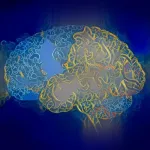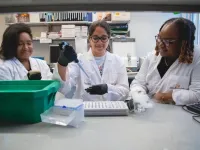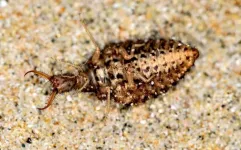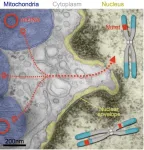(Press-News.org) Researchers have presented a new family of polymer adhesives that offer a sustainable and recyclable alternative to conventional polymer adhesives and can be used across a wide range of applications, from industrial adhesives to surgical superglues. The new chemical approach to aLA polymerization addresses the performance and environmental challenges of traditional polymers, providing environmentally friendly adhesive solutions. Polymer adhesives are ubiquitous in modern life and are widely used in many medical, consumer, and industrial products. Given this diversity, each adhesive material is often tailored for a specific use, and its performance in one application often does not easily translate to another. Moreover, many adhesives are nonrecyclable and contain chemicals or volatile organic substances that are harmful to health and the environment. Thus, there is a growing demand for multipurpose polymer adhesives that work well across various surfaces and environmental conditions while also being non-toxic, environmentally sustainable, and capable of closed-loop recycling. Polymers derived from aLA – a naturally occurring fatty acid – have the potential to address these needs. However, they suffer from spontaneous depolymerization under conditions relevant to most real-world applications.
To address this critical limitation, Subhajit Pal and colleagues developed a family of stabilized aLA polymer adhesives with a wide range of physical properties. Pal et al. found that minor modifications to monomer composition – namely, the incorporation of an electrophilic stabilizer – prevented aLA depolymerization and enabled the practical design of aLA polymer adhesives. The authors synthesized several aLA adhesives and tested them across a range of uses. Pressure-sensitive adhesives demonstrated tenfold higher peel strength than conventional options and worked effectively in both dry and wet conditions; structural adhesives matched the strength of petroleum-derived epoxies and were self-healing and reprocessable; and aLA surgical superglue successfully sealed mouse amniotic sac punctures, improving fetal survival from 0% to 100%. Additionally, Pal et al. developed a closed-loop recycling process that regenerated aLA monomers using only aqueous media, demonstrating their sustainability. “Although aLA is naturally occurring, it is, ironically, manufactured primarily from petroleum-based starting materials,” writes Zhibin Guan in a related Perspective. “Looking ahead, developing commercially viable, high-performance polymeric materials from renewable resources is undoubtedly one of the most important directions in modern polymer science.”
END
Fatty-acid derived polymers yield recyclable and highly versatile adhesives
2024-08-22
ELSE PRESS RELEASES FROM THIS DATE:
Governance needed to ensure biosecurity of biological AI models
2024-08-22
Concerns over the biosecurity risks posed by artificial intelligence (AI) models in biology continue to grow. Amid this concern, Doni Bloomfield and colleagues argue, in a Policy Forum, for improved governance and pre-release safety evaluations of new models in order to mitigate potential threats. “We propose that national governments, including the United States, pass legislation and set mandatory rules that will prevent advanced biological models from substantially contributing to large-scale dangers, such as the creation of novel or enhanced pathogens ...
Spontaneous transfer of mitochondrial DNA into the nuclear genomes in the human brain over the individual’s lifespan
2024-08-22
Somatic nuclear mitochondrial DNA (Numt) insertions are mito-nuclear gene transfer events that can arise in the germline and in cancer. This study shows that Numt insertions arise spontaneously and accumulate in brain tissues during development or over the human lifespan.
#####
In your coverage, please use this URL to provide access to the freely available paper in PLOS Biology: http://journals.plos.org/plosbiology/article?id=10.1371/journal.pbio.3002723
Article Title: Somatic nuclear mitochondrial DNA insertions are prevalent in the human brain and accumulate over time in fibroblasts
Author Countries: United States
Funding: see manuscript END ...
Cancer drug could treat early-stage Alzheimer’s disease, study shows
2024-08-22
UNIVERSITY PARK, Pa. — A type of drug developed for treating cancer holds promise as a new treatment for neurodegenerative diseases such as Alzheimer’s, according to a recent study by researchers at Penn State, Stanford University and an international team of collaborators.
The researchers discovered that by blocking a specific enzyme called indoleamine-2,3-dioxygenase 1, or IDO1 for short, they could rescue memory and brain function in models that mimic Alzheimer’s disease. The findings, published today (Aug. 22) in the journal Science, suggest that IDO1 inhibitors currently ...
Drugs that improve brain metabolism could help Alzheimer’s patients
2024-08-22
Among the many ways neuroscientists think Alzheimer’s disease may strip away brain function is by disrupting the glucose metabolism needed to fuel the healthy brain. In essence, declining metabolism robs the brain of energy, impairing thinking and memory.
Against that backdrop, a team of neuroscientists at the Knight Initiative for Brain Resilience at Stanford’s Wu Tsai Neurosciences Institute have zeroed in on a critical regulator of brain metabolism known as the kynurenine pathway. They hypothesize that that the kynurenine pathway is overactivated as a result of ...
Life after (feigned) death
2024-08-22
A new study led by scientists from the University of Bristol has revealed what animals do after they have feigned death in order to avoid being killed by a predator and what the context of this behaviour is.
Many animals, as a last-ditch defence, become motionless after being contacted by a predator.
This behaviour is so common that it's recognised in such phrases as “playing possum”. It is even said to occur in humans in extreme circumstances.
In previous studies, carried out by the same team using antlion larvae, scientists noticed that they become motionless after being individually handled.
At one point ...
Fisheries research overestimates fish stocks
2024-08-22
Many fish stocks around the world are either threatened by overfishing or have already collapsed. One of the main reasons for this devastating trend is that policymakers have often ignored the catch limits calculated by scientists, which were intended to be strict thresholds to protect stocks. But it has now become clear that even these scientific recommendations were often too high.
In the European Union (EU), for example, fisheries are primarily managed through allowable catch limits, known as quotas, which are set by the European ...
AI tackles one of the most difficult challenges in quantum chemistry
2024-08-22
New research using neural networks, a form of brain-inspired AI, proposes a solution to the tough challenge of modelling the states of molecules.
The research shows how the technique can help solve fundamental equations in complex molecular systems.
This could lead to practical uses in the future, helping researchers to prototype new materials and chemical syntheses using computer simulation before trying to make them in the lab.
Led by Imperial College London and Google DeepMind scientists, the study is published today in Science.
Excited molecules
The team investigated the problem of understanding ...
Mitochondria are flinging their DNA into our brain cells
2024-08-22
NEW YORK, NY (Aug. 22, 2024)--As direct descendants of ancient bacteria, mitochondria have always been a little alien.
Now a study shows that mitochondria are possibly even stranger than we thought.
Mitochondria in our brain cells frequently fling their DNA into the nucleus, the study found, where the DNA becomes integrated into the cells’ chromosomes. And these insertions may be causing harm: Among the study’s nearly 1,200 participants, those with more mitochondrial DNA insertions in their brain cells ...
Revealing DNA behavior in record time
2024-08-22
“DNA, RNA and proteins are the key players to regulate all processes in the cells of our body,” Leiden Professor John van Noort explains. “To understand the (mis-)functioning of these molecules, it is essential to uncover how their 3D structure depends on their sequence and for this it is necessary to measure them one molecule at a time. However, single-molecule measurements are laborious and slow, and the number of possible sequence variations is massive.”
From decades to days
Now the team of scientists developed an innovative tool, called SPARXS (Single-molecule Parallel Analysis for Rapid eXploration ...
Columbia receives $400 million gift for biomedical research
2024-08-22
NEW YORK, NY (Aug. 22, 2024)--Columbia University announced today a new $400 million gift from Roy and Diana Vagelos, which will secure Columbia’s leadership in biomedical science research and education and produce a vast array of compelling opportunities for improving society’s health and wellbeing. The gift is the single largest ever made to Columbia’s medical school and, taken together with their previous giving, establishes Roy and Diana as the most generous donors in the history of Columbia University.
A ...





